I have a soft spot for classic Universal horror. Not that it should come as a surprise – I’m a sucker (ha!) for some vintage Hammer Horror as well, and all other forms of classical horror (even if they may occasionally veer into the realm of kitsch). It’s really hard to overstate the massive influence that the 1931 Universal version of Dracula had on the subsequent adaptations of Stoker’s truly iconic novel. I honestly don’t believe that the character would the same without Bela Lugosi’s truly magnificent central performance, as seen here. Sure, I’m less than convinced about the ending, but most of Tod Browning’s adaptation is a feast for the eyes and pulpy horror classic.
I’ll admit that the ending is a bit strange – seeming to literally come out of nowhere. I don’t think it’s really a spoiler to discuss the ending of an eighty-year-old adaptation of a classic novel, but consider this a spoiler warning. The film is relatively faithful to Stoker’s source material for most of its runtime. It does a bit of tidying up to get elements to fit within the seventy-five minute run-time, like sending Renfield to Transylvania instead of Harker at the start, but it’s about as faithful (give or take) as most adaptations. However, once the movie comes towards the end, things seem to get a bit messy.
Harker and Van Helsing chase Dracula back to the Abbey, where he’s taken Mina. This looks like things might get a bit tense. Dracula has, after all, just killed Renfield. And then… the sun comes up. The mere act of the sun rising is enough to save Mina from Dracula, who evidently decided he wasn’t going to even take a refreshing sip before retiring. “The daylight stopped him,” Mina tells her would-be saviors.“Oh, if you could have seen the look on his face!”
With the sun rising, Dracula retires to his coffin, where Van Helsing can put a stake through his heart in his own damn time. “Get me a piece of stone… anything to help me drive the stake through their hearts,” he urges Harker, but he feels like he could add “no hurry.” It just feels slightly surreal that Dracula isn’t stopped by anything the heroes do. He’s stopped by something that tends to happen once a day, and is then disabled for the heroes to waltz in and take care of in their own manner. There’s no dramatic confrontation, no struggle, no risk. Nothing Van Helsing or Harker actually do affects the outcome in anyway. Instead of chasing Dracula, they could have simply wandered over on their own time and achieved the same result.
It’s a disappointing ending, if only because the rest of the film is so ridiculously enjoyable. It still holds up today, serving as an example of how perfectly cinematic the character of Dracula happens to be. Tod Browning’s direction throughout is simply wonderful, framed in black and white to create a lush and rich atmosphere. He uses lighting to great effect – hiding the off-screen horror of the Vesta through clever use of silhouettes.
The production design is fabulous, with any number of beautiful sets giving the film a theatrical feel – the sense that our cast are just players on some gigantic stage. (Appropriate enough, given that the film is so firmly rooted in the stage adaptation of Stoker’s novel, more than the novel itself.) I’m a big fan of old-style practical effects in movies like these. I love the aesthetic design of early German expressionist cinema movement, for example, which produced Nosferatu, a movie that is very obviously a huge influence on this production.
Here, we get rather wonderful practical effects, like the obviously fake flapping bats dangling from the top of the stage.The production was, apparently, chaotic, but it’s a testament to Tod Browning that he was able to produce a film as fine as this. Watching the film, I’m impressed with Browning’s quick pacing. He seems to favour short, tight scenes, jumping around quickly so as to get to the point. There’s no fat on this seventy-five minute feature, but that doesn’t mean that it isn’t stylish or rich.
Browning feels like he’s being economical, but doesn’t compromise on the style – take the soundtrack, for example. The movie, as with most films of the time, has no musical soundtrack. What little music is used was taken from other sources, including a rather beautiful use of a theme from Swan Lake. (Indeed, it’s hard not to think of this film when watching Black Swan, helping Darren Aronofsky to root his pulpy psychological thriller firmly in the horror genre.)
This adaptation isn’t, of course, the first film of Stoker’s novel. Nosferatu had been produced earlier. However, the producers had lost a copyright case with the Stoker estate, and all copies were urged destroyed. Nevertheless, one can see a strong influence of that take on the character (Count Orlok was, of course, an attempt to create a copyright-free Dracula) on this production. For example, we get that great sequence with Renfield pricking his finger at Castle Dracula, tempting the Count.
The name “nosferatu” is also repeatedly used within the context of the film, even within the very first scene (and then quite a bit after that as well). Of course, the word is rooted in Stoker’s original Dracula, but one could imagine that it would easily have been conflated with “vampire” so as not to confuse the audience. (Much like Renfield and Harker had their roles in the first part of the story merged for efficiency.)
It’s interesting to look at this as a very American adaptation of a very European story. The action remains, of course, based in Europe, but there’s a general sense of decay. The opening line tells us, “Among the rugged peaks that crown down upon the Borgo Pass, are found crumbling castles of a bygone age.” There’s a very conscious sense that the old European aristocratic elements of the story are being consciously emphasised, and that Dracula is seen to embody the spirit of a Europe still trapped in “a bygone age” , right down to the tuxedo and cane, and a monocle. Dracula seems like he comes from “old money”, but he lives in decrepit ruins.
That said, perhaps Dracula himself is the best part of the production. It’s hard not to feel a bit sorry for Lugosi, why only got the role when he agreed to work for next-to-nothing. He became forever linked, in the public consciousness, with the role that made him famous, despite the fact that he only reprised the role once – in Abbott and Costello Meet Frankenstein, of all things. (Still playing other vampires probably didn’t help. Still, it overshadowed the actor’s career, to the point where he ended up unable to appear in anything other than trashy Ed Wood movies.
Still, there’s a reason that Lugosi’s central performance is so iconic. The actor’s speech pattern and movement hav pretty much shaped the character in popular culture – to the point that any parody of Dracula is almost inevitably an exaggeration of Lugosi’s speaking voice or his heightened movements. Lugosi also manages to find some small measure of tragedy in the monster. Stoker’s original book never truly lost sympathy for Dracula the man, although the monster was portrayed a pure fiend. Here, at times, it’s hard not to feel sorry for Dracula.
“To die, to be really dead, that must be glorious,” he laments to Mina, reflecting on his own status as an undead ghoul. “There are far worse things awaiting man than death.” In fact, the last shot we see of Dracula is of the Count slumbering in his coffin, helpless. It helps the audience to feel just a bit of pity for the creature who was ultimately defeated while he was at his weakest. Surely he fell asleep, with Van Helsing and Harker outside (and Mina inside) knowing that he’d never wake again. It’s almost poetic.
Universal’s Dracula is a classic, and one that truly shaped our impression of Dracula. The ending is just a bit strange – it’s almost as if the production had reached their quota of footage and decided to tie things up as quickly as possible. Still, it’s impossible to imagine what Dracula might look like today without the combination of Lugosi’s stately portrayal and Browning’s superb and atmospheric direction.
You might be interested in our other Universal Monster reviews:
- Dracula (1931)
- Frankenstein (1931)
- The Mummy (1932)
- The Invisible Man (1933)
- Bride of Frankenstein (1935)
- The Wolf Man (1941)
- The Phantom of the Opera (1943)
- The Creature from the Black Lagoon (1954)
Filed under: Non-Review Reviews | Tagged: Abbott & Costello Meet Frankenstein, art, Béla Lugosi, Bram Stoker, Carla Laemmle, Count Orlok, dracula, film, frankenstein, horror, Jonathan Harker, Lugosi, Movie, non-review review, Nosferatu, Renfield, review, Romania, Stoker, Tod Browning, universal monsters, vampire, Van Helsing |















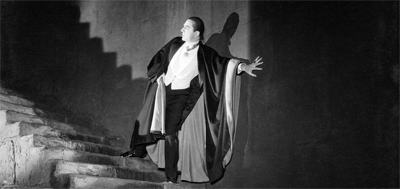
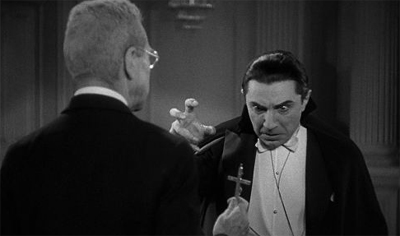
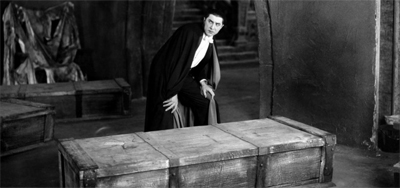

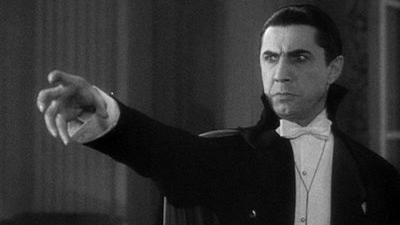
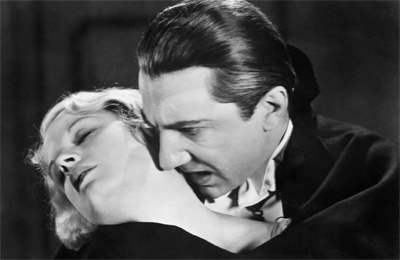






Reblogged this on BookRepublic.
Thanks.
You are welcome.
I saw Dracula for the first time last Halloween. I loved it! It felt like a filmed stageplay, and the lack of music was striking. It was so good at creating a foreboding and heavy atmosphere that I was genuinely frightened by it, at least for the first 30-40 minutes. Toward the end it did drag, making me happy it was only 75 minutes long.
Holy cow, though. Directors could make really scary movies if they combined this level of atmosphere with new filming techniques instead of jumping out at us every 5 minutes. Paranormal Activity nearly achieves this for me, and unsurprisingly I am genuinely frightened by that, too!
To add one more thought, I am really shocked that Dracula doesn’t make the top 250 on IMDB, which means it won’t be part of my little quest. Happily, Nosferatu is on there, one I haven’t seen.
But no Dracula…it’s just so weird to me!
You are right about Lugosi’s impact on Dracula’s (or vampires in general) image today. I still don’t like Browning’s version and prefer the spanish version much more. Have you seen that one?
I am working on my own (german) review-series on the universal monsters and I am really looking forward to read your other reviews asap. Especially “The Bride of Frankenstein” which i hated so bad 😀
You hated the Bride of Frankenstein? I’m now very curious to hear what led to that extreme reaction. 🙂
Ok, maybe “hate” was a little bit too much. 😉
Sorry if the following is bad english. It’s not my first language and I am a bit rusty i guess 🙂
“The Bride of Frankenstein” combines a lot of things bad sequels tend to suffer from.
Surprise, Surprise! The monster isn’t dead! I really didn’t like the story. It made almost no sense to me at all. The monster suddenly turns into a killer machine, even stronger than the Hulk. Pretorius is a cool character and Ernest Thesiger gives a great performance. But I think his appearance is implausible. How did he know about Frankensteins work? Keep in mind that the monster was born only a couple of days ago. And what about those homunculi in the glasses? I know that’s kind of Whales humor. But I thought it didn’t really fit into the movie as a whole.
And what about the ending???
By the way, I also didn’t like the new monster make-up.
Technically (cut, camera etc) “The Bride…” might be better then “Frankenstein”. But I was too upset with the story (if you want to call it so) to enjoy it.
Thanks for such a detailed article, Darren!